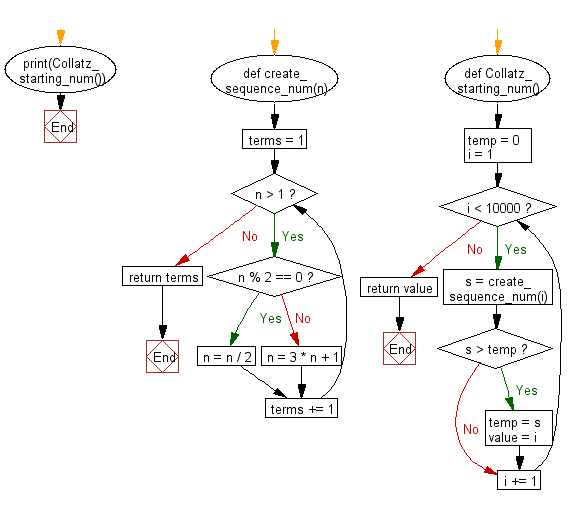Python Challenges: Find the starting number, under ten thousand will create the longest chain
Python Challenges - 1: Exercise-42 with Solution
Write a Python program to find the starting number, under ten thousand will create the longest chain.
From Wikipedia - The Collatz conjecture is a conjecture in mathematics that concerns a sequence defined as follows: start with any positive integer n. Then each term is obtained from the previous term as follows: if the previous term is even, the next term is one half the previous term. If the previous term is odd, the next term is 3 times the previous term plus 1. The conjecture is that no matter what value of n, the sequence will always reach 1.
Sample Solution:
Python Code:
def create_sequence_num(n):
terms = 1
while n > 1:
if n % 2 == 0:
n = n / 2
else:
n = 3 * n + 1
terms += 1
return terms
def Collatz_starting_num():
temp = 0
i = 1
while i < 10000:
s = create_sequence_num(i)
if s > temp:
temp = s
value = i
i += 1
return value
print(Collatz_starting_num())
Sample Output:
6171
Flowchart:

Python Code Editor:
Contribute your code and comments through Disqus.
Previous: Write a Python program to find the first triangle number to have over n(given) divisors.
Next: Write a Python program to compute s the sum of the digits of the number 220.
What is the difficulty level of this exercise?
Test your Programming skills with w3resource's quiz.
Python: Tips of the Day
Find current directory and file's directory:
To get the full path to the directory a Python file is contained in, write this in that file:
import os dir_path = os.path.dirname(os.path.realpath(__file__))
(Note that the incantation above won't work if you've already used os.chdir() to change your current working directory, since the value of the __file__ constant is relative to the current working directory and is not changed by an os.chdir() call.)
To get the current working directory use
import os cwd = os.getcwd()
Documentation references for the modules, constants and functions used above:
- The os and os.path modules.
- The __file__ constant
- os.path.realpath(path) (returns "the canonical path of the specified filename, eliminating any symbolic links encountered in the path")
- os.path.dirname(path) (returns "the directory name of pathname path")
- os.getcwd() (returns "a string representing the current working directory")
- os.chdir(path) ("change the current working directory to path")
Ref: https://bit.ly/3fy0R6m
- New Content published on w3resource:
- HTML-CSS Practical: Exercises, Practice, Solution
- Java Regular Expression: Exercises, Practice, Solution
- Scala Programming Exercises, Practice, Solution
- Python Itertools exercises
- Python Numpy exercises
- Python GeoPy Package exercises
- Python Pandas exercises
- Python nltk exercises
- Python BeautifulSoup exercises
- Form Template
- Composer - PHP Package Manager
- PHPUnit - PHP Testing
- Laravel - PHP Framework
- Angular - JavaScript Framework
- Vue - JavaScript Framework
- Jest - JavaScript Testing Framework
